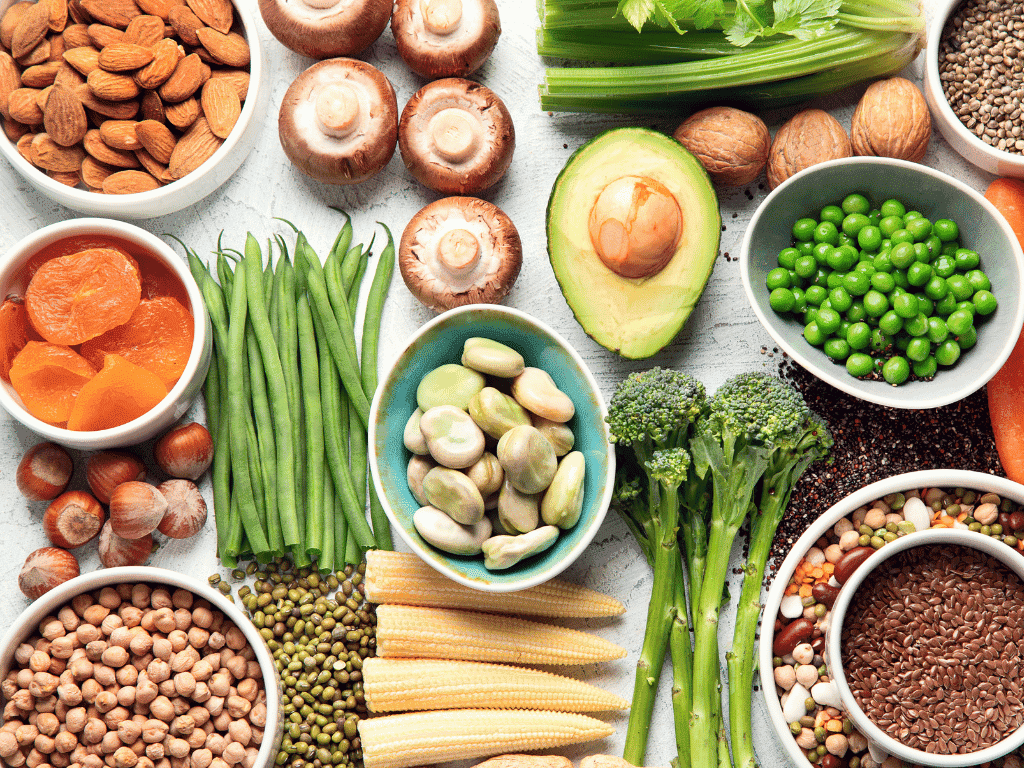
Want to add some muscle to your meatless meals? Look no further!
Whether you're a vegetarian, vegan, or want to reduce your meat intake, plenty of high-protein plant-based foods can help fuel your active lifestyle.
From tofu and tempeh to beans and legumes, we've rounded up the best protein-packed vegetarian foods that will satisfy and energize you.
So, let's power up those plates and prepare for some deliciously nutritious eats!
Plant-Based Protein Sources – Are They Good Enough?
Some people think that animal products are the only or best protein sources, but this is not true. Many high-protein vegetarian foods can provide all the amino acids you need for optimal health. Amino acids are the building blocks of protein, some of which are the essential amino acids our bodies cannot make themselves.
Although there are incomplete plant-based protein sources, meaning they lack one or more essential amino acids or have them in low amounts, you can still get all the protein you need from plants.
- Eat a variety of plant based protein sources such as grains, beans, nuts, and seeds..
- Combine complementary plant based protein sources throughout the day, or in a meal (such as grains and beans) as their amino acid profiles “complete” each other. In other words, grains will provide amino acids that beans are low in, and vice-versa.
To power up your meatless meals with high-protein vegetarian options, check out some of these delicious recipes!
The Best High-Protein Vegetarian Foods You Need to Know About
1. Legumes and Their Benefits
Legumes are a group of plants that produce pods with seeds inside them. They include beans, lentils, peas (green peas, split peas, chickpeas), peanuts and soybeans. Legumes are high in protein and rich in fiber, iron, and other essential nutrients (like carbs, vitamins and minerals).
You can enjoy legumes in many ways, like soups, stews, curries, salads, burgers, dips, or snacks. You can also use legume flour to make baked goods or pasta. Or you can try adding legume-based protein powders like pea protein to your foods to increase their protein content.
Approximately protein content of legumes per 1 cup (cooked), based on USDA Nutrient Database:
- lentils -18g
- black beans - 15g
- chickpeas - 14.5g
- split peas - 16g
- green peas (sweet) - 8.5g
2. Lentils as a Meat Substitute
Lentils are a type of legume in different colors--brown, green, red, and yellow.
They are rich in protein (18g per 1 cooked cup), fiber, iron, folate, and other nutrients. Lentils have a hearty texture and a mild flavor that can mimic meat in many dishes. When cooking with lentils, it is important to remember that they will absorb the flavors of the other ingredients they are cooked with.
Cook in water or broth until soft and tender, and add them to soups, stews, curries, or salads. You can also use lentils as a meat substitute in burgers, lasagna, shepherd's pie, tacos, or sloppy joes.
3. Tofu and Tempeh: Versatile Cooking Staples
Tofu and tempeh are two popular soy products widely used in vegetarian cuisine.
- Tofu is made from coagulated soy milk that is pressed into blocks.
- Tempeh is made from fermented soybeans that are formed into cakes.
Both are high in protein, calcium, iron, magnesium, and other nutrients.
Tofu and tempeh are versatile cooking staples. You can marinate them in different sauces or spices, bake, fry, grill, or crumble them into scrambles or patties.
Also, use tofu and tempeh as meat substitutes in various dishes.
While these two options are rich in protein, they aren’t viable sources for people with soy allergies.
Approximately protein content of tofu and tempeh per 1 cup, based on USDA Nutrient Database:
- tofu - 20g
- tempeh - 33.7g
4. Nuts and Seeds as Protein Sources
There are many different nuts and seeds, each with a unique flavor and texture. Some of the most popular are almonds, cashews, pistachios, pumpkin seeds, and sunflower seeds. Nuts and seeds are another source of plant-based protein, healthy fats, fiber, vitamins, minerals, antioxidants, and more.
You can eat nuts and seeds raw or roasted as a snack or add them to salads, cereals, yogurt, smoothies, or baked goods. Also, make nut butter or milk from them and use flax or chia seeds as egg substitutes in certain dishes.
While nuts and tree nuts are major allergens, seeds rarely cause allergies and can be consumed by most people.
Approximately protein content of various nuts and seeds, based on USDA Nutrient Database:
- almonds, 10 count - 2.5g
- hazelnuts, 10 count - 2g
- pistachios, 10 count - 1.5g
- sunflower seeds, dry roasted, 2 tbsp. - 3g
- pumpkin seeds, roasted, 2 tbsp. 3.8g
5. Quinoa: A Protein-Rich Grain
Quinoa is a pseudo-cereal often considered a grain. It is native to South America and has been cultivated for thousands of years by the Incas. Quinoa is high in protein compared to other cereals like oats, rice, and barley. It provides about 8 grams of protein per cup of cooked quinoa compared to 4g protein a cup of cooked rice and 6g protein in a cup of oatmeal.
It’s also a rich source of fiber, iron, magnesium, zinc, and other nutrients. Quinoa has a nutty flavor and a fluffy texture when cooked. It can be used as a base for salads, bowls, or pilafs. Also, add it to soups, stews, or casseroles. You can even make quinoa flour or flakes from it.
Tips for Getting Enough Protein on a Vegetarian Diet
- Eat a variety of plant foods throughout the day. This will ensure you get all the essential amino acids from different sources.
- Include at least one high-protein food in each meal and snack. This will help you meet your daily protein needs and keep you satisfied for longer.
- Use plant-based protein powders if needed. These can help you boost your protein intake if you have trouble getting enough from food alone especially if food allergies or intolerances are present.
- Track your protein intake. If you are unsure how much protein you get, use online tools or apps to track your intake.
- Add a protein boost to your meals. Sprinkle nuts and seeds on salads or soups, add beans to tacos or burritos, and top sandwiches with tofu or other plant-based proteins.
Eating meatless meals does not have to be a boring experience. With the right vegetarian ingredients, you can create nutritious and delicious dishes packed with protein.
If you need a convenient and tasty way to add more protein to your vegetarian diet, visit Growing Naturals today!
We make the cleanest, most digestible organic rice protein, organic pea protein, and benefit blends that are high in quality and flavor. Use them in smoothies, baked goods, or snacks that fuel your body with plant-based power.
Have fun getting creative in the kitchen and enjoy all the health benefits of swapping out animal proteins for plant-based ones!
